Short Sunderland DD846, Clare Island, Mayo, May 1943
At 03:07 hours of the 25th May 1943, an aircraft was observed
by members of the Irish Coast Watching Service (CWS) at LOP No.
57, Roonagh Point, flying north east over Clare
Island. It was also heard and plotted by Corraun
Look Out Post near Achill Island to the north of Clare Island.
It was reported to have crashed into the sea after passing
close to the island. Immediately the men of the CWS began
to make arrangements to investigate and report the incident to
higher command. About three hours after the crash, Cpl.
Gallagher of Corraun LOP along with others arrived on the scene
and met with two local Clare Island men who had also rowed
out. These two were in fact Dick Hayes, Clare Island
lightkeeper and Michael Joe O'Malley, well-known local farmer
and fisherman from Ballytoughey, Clare island - who owned the
currach they used. Their actions are also recorded in the
register of the lighthouse itself.
Sadly, all that was found were the floating remains of six
airmen. The group then together took the bodies on board
their boats and conveyed them to Clare Island where they were
placed in an out building of an island resident. The Garda
on the mainland having been informed called out local Red Cross
personnel and an ambulance from Castlebar in the hope that
survivors might be treated. The six airmen were identified
from belongings found on them and the sad task of preparing
their bodies for transport began. They were taken by local
boat to Roonagh Pier where an Irish military party awaited them
with six coffins. From there, they were brought to
Castlebar Barracks, and following issuing of death certificates,
sent onwards with Captain Birthistle of the Armies G2 section to
the border with Northern Ireland, passing through the towns of
Swinford and Tubbercurry on way to Belleek on the 27th
May. Of the six bodies, five could be identified by
personal belongings as:
E F Page; Robert Bruce Bryers; W G Hopps; Sherwood, Ronald; A D
O’Dowd.
The sixth body could not be identified by the Irish
authorities. All six were afforded military honours by the
Irish Army during the hand over.
On the day after the crash, a seventh body was washed up on
Dukenella Strand, Achill, the larger island to the north of
Clare Island. This was identified locally as J W Clarke
and sent to the border on the 27th where the Irish Army 17th
Battalion provided military honours for the handover of the
remains.
Other items found in the water included a dingy and log book
which identified the aircraft as a Sunderland Mk III DD846.
Those members of the Irish military reporting to higher command
at the time made mention of the possibility that the aircraft
struck a summit on Clare Island called “Beetle Hill”.
However, the writers also point out that the airmen when found
were wearing life preservers and had removed their flying
boots. The Irish officer also comments that the aircraft
had been in contact with the RAF base at Castle Archdale and it
was known that it was suffering some problems and that Castle
Archdale knew the approximate location of the crash. It
should be noted here that the author of these reports likely was
mixing up some of the local place names in so much as that the
highest part of Clare Island is known as Cnoc Mor or Big Hill,
and the western tip of the Island is referred to as Beetle Head
or Kinatevdilla.
On the morning of the 25th May, at the RAF Flying boat base at
Bowmore, Argyll, Scotland, the men of 422 Squadron, Royal
Canadian Air Force awaited news of their comrades in Sunderland
DD846, which had left the previous day on a patrol
mission. They had been directed to land at Castle Archdale
in Northern Ireland while on their patrol. The eleven
young men would never return. The Squadron ORB for
the day recorded:
Form 541, Record of Events:
1353 Airborne Bowmore on A.S. Escort to HX239
1915 TKKE. 5531 Estimated time & position
on patrol
0015/25 LTDQ 1040 Estimated time end position off patrol
0100 MFB 1 “Land at Castle Archdale’ message aknowledged
0210 MT Castle Archdale “Expect to arrive 0330”
0244 A/C asked for course to steer for Castle Archdale, but
signals were to faint for bearing to be obtained.
0355 Message from Castle Archdale “ When do you expect to
arrive”. Message acknowledged by very faint signals but
aircraft failed to arrive at Castle Archdale.
A/C Subsequently reported crashed off Beetle Head, Clare
Island, in Clew Bay, Co. Mayo at 0405. & members of
crew Killed. W/O Thomson, Sgt. Purvis, Sgt. Rowe, Sgt.
Hird missing believed killed.
In the following days, members of the Squadron would have to
attend the funerals of the Canadian members of the crew at the
cemetery in Irvinestown.
The crew of the aircraft were:
F/O. Ernest F. Paige J/6007 + RCAF (Captain / First Pilot) -
Killed in Action, buried Irvinestown Cemetery
F/O James W. Clarke J/12829 + RCAF (2nd Pilot) - Killed in
Action, buried Irvinestown Cemetery
Sgt. William G. Hopps R/133113 + RCAF (3rd Pilot) - Killed in
Action, buried Irvinestown Cemetery
W/O. Wallace Roy Thompson R/76084 + RCAF (Navigator) - Missing,
named on Runnymede Memorial
Sgt. James Hird 935914 + RAFVR (Flight Engineer) - Missing,
named on Runnymede Memorial
Sgt. Donahan A. O’Dowd 527272 + RAF (Flight Engineer) - Killed
in Action, buried Bandon Hill Cemetery, Surrey
Sgt. John Rowe 623554 + RAF (WOM/AG) - Missing, named on
Runnymede Memorial
Sgt. David Purvis 1309732 + RAFVR (WOP/AG) - Missing,
named on Runnymede Memorial
Sgt. Derek H. Richardson 1172574 + RAFVR (WOP/AG) - Killed in
Action, buried Nottingham Northern Cemetery.
Sgt. Ronald Sherwood 1289040 + RAFVR (WOP/AG) - Killed in
Action, buried in Waterhouses Cemetery, Durham.
W/O II Robert B. Bryers R/125283 + RCAF (Air Gunner) - Killed in
Action, buried Irvinestown Cemetery
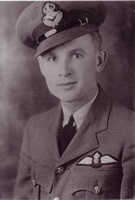
F/O Ernest Franklyn Paige RCAF |

F/O James W Clarke RCAF |
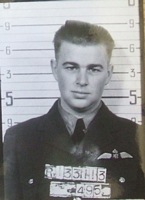
Sgt William G Hopps |
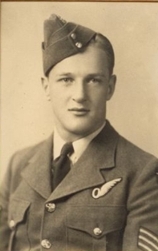
W/O II Wallace Roy Thompson RCAF |

Sgt James Hird |

Sgt Donahan Anthony O'Dowd |

Sgt Jone Rowe |
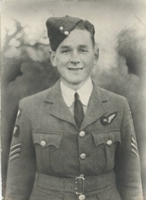
Sgt David Purvis |

Sgt Derek Harold Richardson, Nottingham - Seeking
relatives |
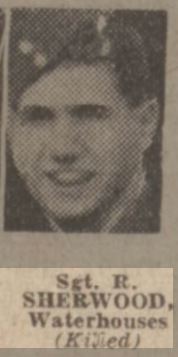
Sgt Ronald Sherwood, Esh Winning, Durham - Seeking photo |

W/O Robert Bryers (Bruce Glasgow), RCAF Philadelphia |
|
If you can provide any help in finding relatives of these
three members of the crew I would be most greatful:
Derek Richardson, Nottingham, England. Son of Florrie
and Harold Richardson. He was married to Joan Offiler.
Ronald Sherwood, Esh Winning, Durham, England. Son of
Charles and Sarah Ann Sherwood.
Robert Bryers (Bruce Glasgow), Philadelphia,
Pennsylvania. Brother of Dorothy Pursley of Arizona. Son of
Elizabeth Bryers (nee McKnight) and step son of John H Bryers.
Be was born Bruce Glasgow in California in 1921, fathers name
James Wendall Phillips Glasgow or Phillip Glasgow.
F/O. Ernest F. Paige J/6007 + RCAF (Pilot)
 Photo via James
Stewart, Fermanagh. Aged 27, F/O Paige was son of Ernest
B. Paige and Elva E. Paige, of Bridgeport, Ontario, Canada per
the CWGC database. His remains were recovered from the
sea and were interned in Irvinestown Cemetery, County
Fermanagh, Northern Ireland. F/O Paige was the lead
pilot and captain of the crew of Sunderland DD846.
Photo via James
Stewart, Fermanagh. Aged 27, F/O Paige was son of Ernest
B. Paige and Elva E. Paige, of Bridgeport, Ontario, Canada per
the CWGC database. His remains were recovered from the
sea and were interned in Irvinestown Cemetery, County
Fermanagh, Northern Ireland. F/O Paige was the lead
pilot and captain of the crew of Sunderland DD846.
F/O Paige had been decorated with the Distinguished Flying
Cross in 1942 for his flying operations with 407 (RCAF)
Squadron. The citation for his award was published in
the London Gazette newspaper dated 5th June 1942.
F/O James W. Clarke J/12829 + RCAF (Pilot)
 James Clark
photographed with his sister Blanche in 1942 in
Winnipeg. Received via the O'Dowd family.
James Clark
photographed with his sister Blanche in 1942 in
Winnipeg. Received via the O'Dowd family.
Sgt. William G. Hopps R/133113 + RCAF (Pilot)
 William was son
of William F. Hopps and Emma E. Hopps, of Calgary, Alberta,
Canada. He was 24 years of age. His remains were
recovered from the sea and lie buried in Irvinestown Cemetery
alongside his comrades.
William was son
of William F. Hopps and Emma E. Hopps, of Calgary, Alberta,
Canada. He was 24 years of age. His remains were
recovered from the sea and lie buried in Irvinestown Cemetery
alongside his comrades.
Sgt. Hopps service record reveals that he had arrived in the
UK in November 1942 and was assigned to 422 Squadron in
December of that year. His record shows his attachments
with the squadron to RAF station at Dyce and Oban. He
had joined the Canadian Army in 1940 and was serving in
Alberta with an Anti Aircraft Battery at the time of his
enlistment with the Air Force.
William Hopps was the third pilot on the aircraft on this
mission. Long range missions with the Sunderland used
three pilots to allow relief on the long over water flights.
The photo attached comes from his RCAF service file in the
Canadian National Archives.
W/O II Wallace Roy Thompson R/76084 + RCAF (Navigator)
 Aged 23,
Wallace was Son of Archibald and Sadie Hattie Thompson, of
Eureka, Pictou Co., Nova Scotia, Canada. His remains
were never recovered and his named is entered on the Runnymede
Memorial.
Aged 23,
Wallace was Son of Archibald and Sadie Hattie Thompson, of
Eureka, Pictou Co., Nova Scotia, Canada. His remains
were never recovered and his named is entered on the Runnymede
Memorial.
Wallace’s family were kind enough to reply to a letter
published in the New Glasgow, nova Scotia newspaper in
2009. His niece Susan wrote: I live in the
province next to Nova Scotia called Prince Edward Island and
while I was not born until after Uncle Wally died, I know
quite a bit about him. My grandparents, Archie and Sadie, as
well as my father, aunts and uncles made sure that we all
remembered him. In fact my husband and I have been to Clare
island twice...once in fall of 2005, and once in May of this
year.
When I became aware of the monument on Clare Island, I
knew I had to go there....and my husband took me there as my
50th birthday gift. We saw the monument in the small
cemetery and met some islanders who remembered the crash in
great detail. By the way, there were 2 monuments. the first
one was erected in 1993 by Garry Pentland, another war
historian who lived in County Tyrone, Northern Ireland. This
was replaced by the current stone in 1996 by Garry Pentland
and Chris O'Grady a leading figure on Clare
Island. The family of the pilot, Ernest Franklin
Paige, were present for that ceremony in 1996.
To my knowledge, the only family members to visit Clare
Island other than us were the Paige Family. When we were
there on our first visit in 2005, we were so moved by the
remembrance of the crash by the Islanders that we decided to
do what we could to thank them. We worked with the Canadian
government to have some type of formal thank you delivered
to the people of Clare Island. As a result of this effort,
the Canadian Government made a formal presentation on Clare
Island on May 9th, 2009. The Canadian Ambassador to Ireland,
Patrick Binns, and Major General Joe Hincke from the
Canadian Armed Forces, as well as my husband and I travelled
to the Island to present a certificate of thanks and to lay
wreaths at the monument.
Sgt. James Hird 935914 + RAFVR (Flight Engineer)
Aged 23, son of Ernest James Hird and Alethea Hird, of West
Hartlepool, Co. Durham. His body was not
officially recovered and his name was entered on the Runnymede
Memorial.
James’s sister Olga in 2011 provided the attached photos and
narrative about her late brother.
James was a very sporty person and also used to go camping
a lot with his pals. he loved to go motor bike
scrambling and would often come home covered in mud.
He also made model planes from balsa wood. He was
also a good swimmer and once saved a young lad from drowning
in Hartlepool Docks.
James went to Avenue Road and Church Square School in
Hartlepool and left at 14 to start work at Duttons Garage as
an apprentice mechanic. I presume he would have
returned there after the war.
Wallace Roy Thompson's family kept in touch for a while
with my family and he spent a leave with my family at our
home.
We also wrote to James Clarke's sister Blanche Clark,
she wrote to my mother and family until they died.
I then wrote to her right up to the time of her
death. I sent holiday snaps and xmas cards but
received no reply so I presumed that she had died.
Please find enclosed photocopies of two
photographs. One is a photo of James on his moterbike
in Vicarage Gardens Hartlepool where we lived.
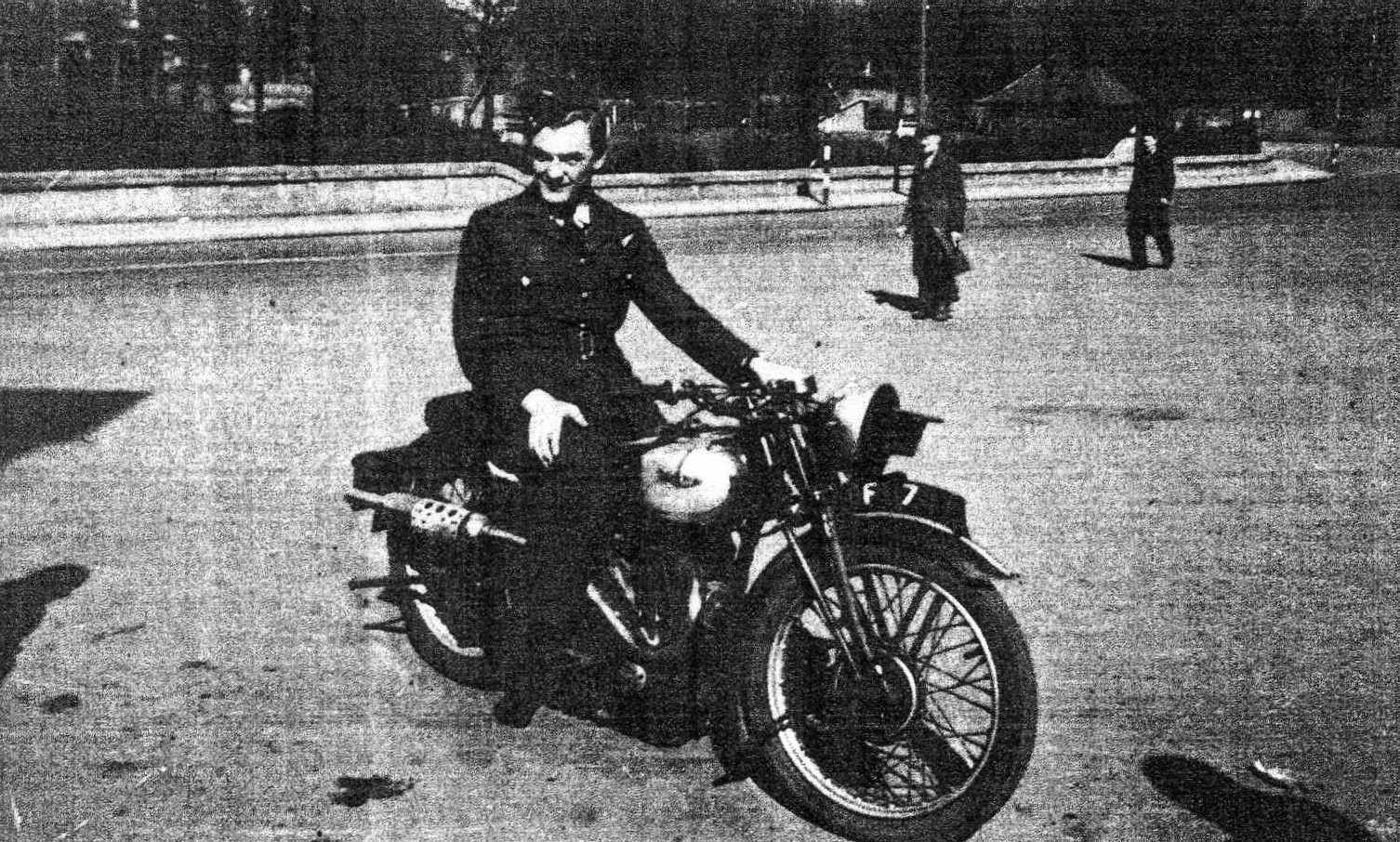
The other photo is of him with Wallace Roy Thompson his
friend and crewmate which may be useful as I notice you have
not got a photo of him.
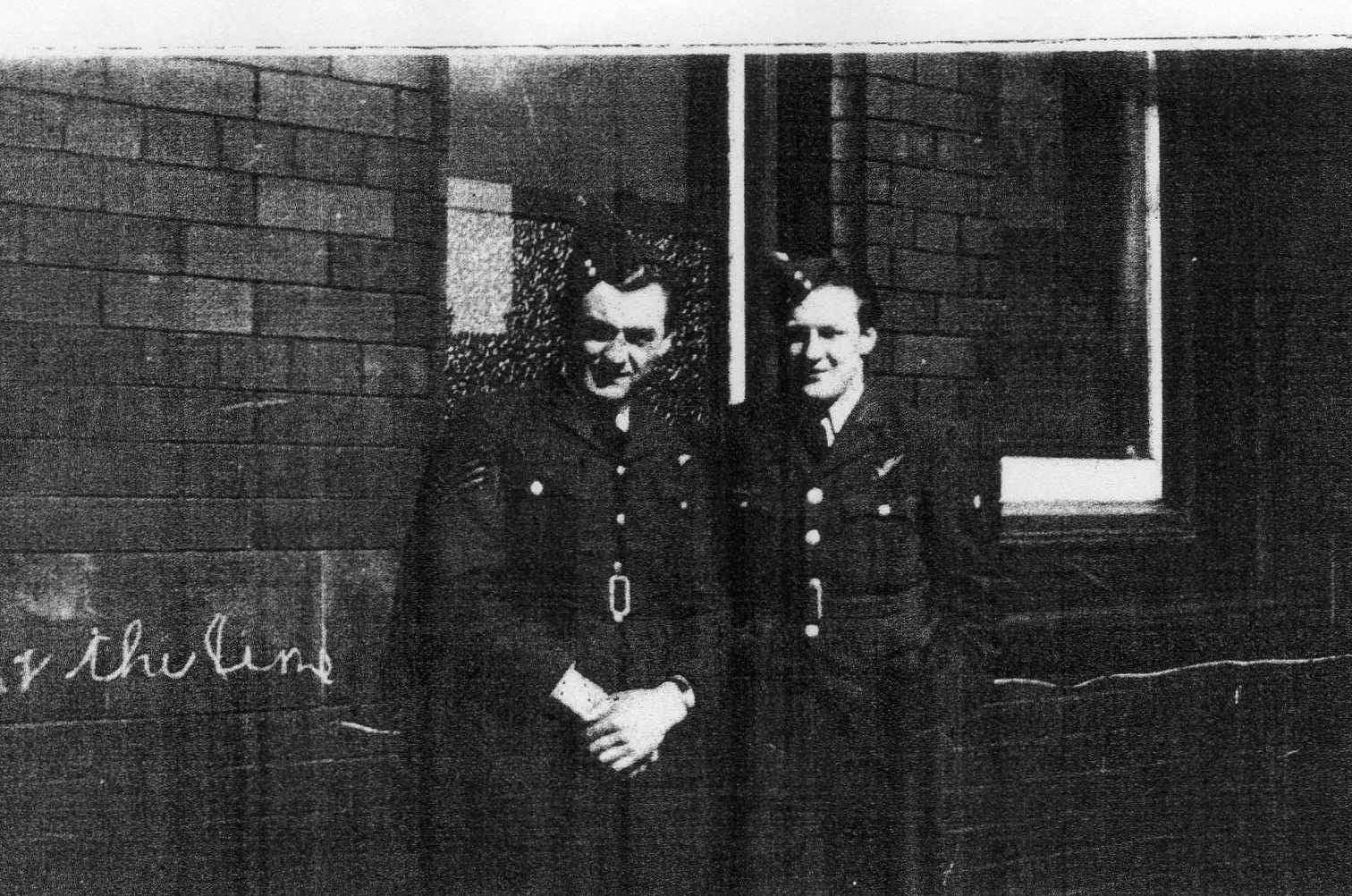
The Hartlepool Northern Daily Mail on May 27th carried a
notice of his being posted missing and mentioned that he had
been formerly employed at a local garage and was an old boy of
Church Square school.
Sgt. Donahan A. O’Dowd 527272 + RAFVR (Flight Engineer)
Donahon Anthony pictured at center with his brothers during
the war.
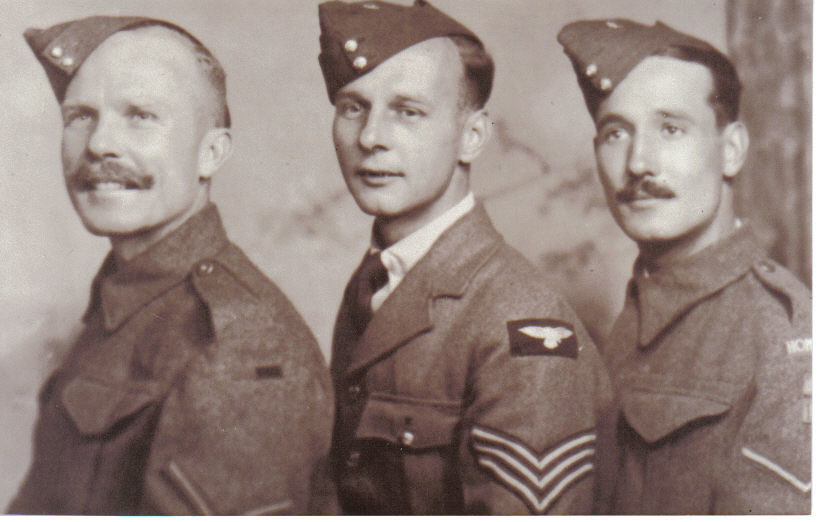
His brother, Michael George O’Dowd, at left in the photo
above, also died in service in 1944 and lies buried in Bone
War Cemetery, Algeria. Donahan and his brothers were
born in India. His remains were recovered from the sea
and were returned to his family for burial. His mother
Ellen Ivy O’Dowd died in 1939 and her husband Michael James
O’Dowd died in 1941. Donahon is buried alongside them in
Bandon Hill Cemetery, Surrey. Details of the family
history came from his nephew Michael O’Dowd and great niece
Lizzie Johnson. Lizzie’s family still hold copies of a
letters sent to Donahan’s third brother John. Sgt Deely
of the Irish police and Rev. Jennings the local Roman Catholic
priest sent letters to John O’Dowd following the crash.
These letters are presented later in this report. Lizzie
was also able to supply copies of photographs that were sent
to her family by the sister of Canadian James Clarke, Blanche.
Sgt. John Rowe 623554 + RAFVR (Wireless Operator/Air
Gunner (WOP/AG))
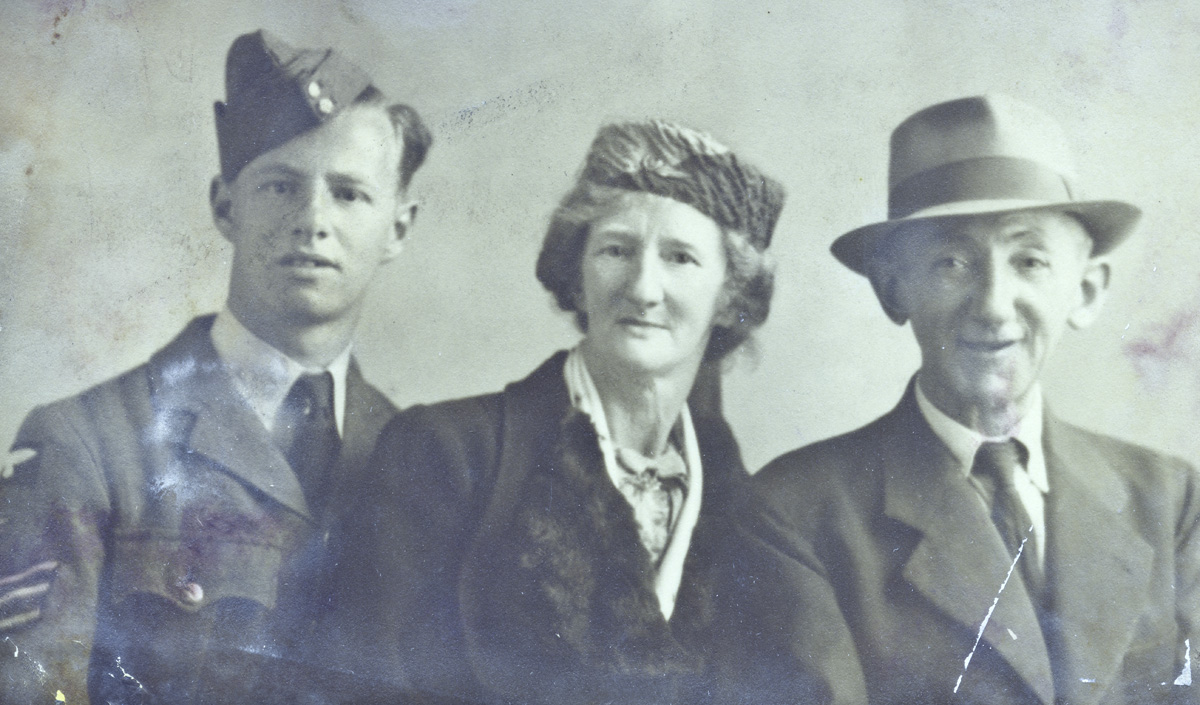
John was one of the crew members from this crew listed on the
CWGC database with no family information and, being Missing in
Action, no burial location that might have hinted as to where
he came from. Luckily his nephew Christopher Rowe in
Canada remembers him on his family tree and hence provided the
vital link.
John was born in 1920 to Elizabeth Ann and George William
Rowe. Christopher Rowe had this to say about him:
John was born in South Shields, Durham in 1920, son of a
merchant seaman and the middle of six brothers and one
sister. It was very much a working class family - father
away at sea a lot, 4 boys sharing a bed in a small terrace
house, etc. My father Francis Rowe was about two and a half
years younger than John and as the closest in age of the
family, the two were very close and apparently inseparable
as children. My dad followed John into the RAF, serving in
Bomber Command and demobilizing after the war as a F/Lt.
(The other brothers served in the Army and Merchant Marine.)
John was known to his brothers and friends as 'Mick' - why,
I have no idea. Unfortunately my father died in 1967 and the
rest of his family have all passed away since, meaning I
don't have a great deal of detail of the family history.
Sgt. David Purvis 1309732 + RAFVR (Wireless Operator/Air
Gunner (WOP/AG))
 David Purvis was
another crew member with no family details on the CWGC
database. His remains having not been recovered he is
also recorded on the Runnymede Memorial.
David Purvis was
another crew member with no family details on the CWGC
database. His remains having not been recovered he is
also recorded on the Runnymede Memorial.
Luckily David’s grandson seen messages on the internet
inquiring gof David came from South Sheilds and was able to
confirm that David actually came from Aberdeen. His name
appears on the Roll of Honour in the Scottish National War
Memorial, this stating that he was born in Dunfermline.
A family notice in December 1943 in the Aberdeen Weekly
Journal states he was second son of Mr and Mrs A Purvis,
Aberdeen, and the dearly beloved husband of Isabel Robertson,
19 Wallfield Place, Aberdeen (Late of 51 Middlefield Terrace)
Sgt. Derek Harold Richardson 1172574 + RAFVR (Wireless
Operator/Air Gunner (WOP/AG))
Derek’s remains were recovered from the water and are
recorded as being buried in Nottingham Northern
Cemetery. No family details are given by the CWGC but it
can be determined that his parents were Florrie and Harold
Richardson. Sgt Richardson was born in 1920 in
Nottingham.
The Nottingham Evening Post of 28 May 1943 carried the news,
‘Sgt. Derek Harold Richardson R.A.F., of 90 Garfield-road,
Nottingham, has been killed in air operations’. The
small image of Derek was included on the same page.
On the 29th May, the same paper carried this family
announcement: RICHARDSON. —In May, Sergt. Derek Harold,
of 90 Garfield road, Radford, killed air operations, dearly
beloved husband of Joan, and much loved son of Mr. and Mrs.
Harold Richardson, 573 Wells-road. Mapperley.
Derek had married in early 1942 in Nottingham to Joan
Offiler. His brother in law Frank E Offiler, was a POW
during the war, having served with the Sherwood Foresters
Regiment.
Sgt. Ronald Sherwood 1289040 + RAFVR (Wireless Operator/Air
Gunner (WOP/AG))
Aged 22, Sgt Sherwood was Son of Charles and Sarah Ann
Sherwood, of Esh Winning. He is buried in Waterhouses
Cemetery, Esh Winning, Durham. The grave has both a
family memorial kerb and a CWGC headstone.
The England and Wales National Probate Calendars and The
Newcastle Journal and North Mail of 3rd June 1943 listed a Sgt
Ronald Sherwood as killed in action with an address at 47
Deerness Place, Waterhouses. His name is among those on
the memorial in St Pauls church, Waterhouses.
It is believed he had one sister named Eva.
W/O Robert Bruce Bryers R/125283 + RCAF (Air Gunner)
Robert Bruce Bryers appears to have been born Bruce M Glasgow
in Long Beach California on 21 May 1921. His father’s
name was Phillip Glasgow according to his enlistment papers or
James Wendall Glasgow according to his Confirmation record in
July 1930. His mother was Elizabeth McKnight, from
Philadelphia. At enlistment W/O Bryers appears to have
said that both his parents were dead but at the same token,
his mother is still listed as his next of kin on other RCAF
documents. His step father was John Henry Bryers.
The 1930 census shows John and Elizabeth Bryers living in
Philadelphia with child Robert Glasgow. No other
siblings are in the house. His enlistment papers
list a Miss Dorothy Pursley of Arizona as a sister. City
directories do show addresses for a William A Pursley and what
is assumed his wife, Dorothy.
Robert’s service record is very confused as it lists his
mother as being dead prior to his enlistment however there
appear to be communications with her after his death and after
the war. It also includes mention of Robert’s birth
father as having been killed at Dunkirk while serving with the
‘Black Watch’ however it has not been possible to identify
such a casualty from the CWGC lists. This is given as a
reason for Robert wanting to sign up to join the Canadian war
effort.
Below is one of the photos sent by Blanch Clarke to the O’Dowd
family.

Written on the back: Churchyard of Presbyterian Church,
Irvinestown, County Fermanagh, Ulster – snapshot taken by
George Clarke in Spring of 1946
In 1997, a memorial plaque was raised in the church yard on
Clare Island in honour of the men of DD846. Relatives of
the Paige family were in attendance at the unveiling.
The Ex air gunners association reported the story in their
1997 magazine:
Memorial Plaque Erected to Lost Airmen on Clare Island
Fifty three years after eleven airmen from 422 Sqdn. RCAF
lost their lives after crashing into the sea just off
Thormore* Mountain on Clare Island, Ireland, a memorial
plaque was at last erected in their memory. A group of
ten relatives and friends of the eleven young men travelled
from Canada and the USA especially to attend the ceremony.
Mass was especially dedicated to the memory of the young men
and their families, and the local choir group sang
beautifully, accompanied by flautist Margaret Duffy, who
played hauntingly throughout. The unveiling ceremony was
carried out by Robert and Nancy Paige, brother and sister of
the Pilot, Ernest Franklin Paige.
Robert and Nancy, until recently, were unsure where
Ernest, Captain of a Sunderland Flying Boat, was killed. It
is good to be here and get filled in on all the details,"
said Nancy. "Ernest and Bill (a brother in the army) were
killed about a year apart; I was around 10 at the time.
Retired Island Postman, Michael James Moran, was one of
those able to fill in the Paige’s on the last minutes of the
ill-fated Sunderland as it tried to return to Lough Erne
from a U-boat hunting mission in the Atlantic. "She came in
from the West about two in the morning on May 25, 1943",
recalled Michael, "There was some fire leaving her. She went
out by the corner of that big hill there before going down,
but her tail was up for quite a while after that.” Several
bodies were recovered by Islanders in currachs but the
remains of four of the crew were never found.
Islander Chris O'Grady recalled seven bodies lined up
in the old fish store as shocked locals came to pay their
last respects. Nancy said, "Now we have been to Fermanagh
where Ernest is buried and Clare Island where he died, I
feel a little happier. We feel that we have shared how he
must have felt during his last few months.”
It is understood that this memorial was arranged by Tyrone man
Garry Pentland along with local islanders. Garry had
been active for many years in raising memorials to many of the
young airmen who lost their lives in crashes in Ireland.
Indeed, Garry had contacted many of the families of those
onboard DD846 many years before the advent of computers and
the internet.
*In the above magazine account, ”Thormore Mountain” is another
misnomer, Thormore is a village and/or area at the west end of
the Island.
I am indebted to local man Dermot Phelan for providing
corrections to the place names recorded in the various reports
referred to in this article.
Below is a copy of a letter sent by Father Jennings from Clare
Island to John O’Dowd, brother of Donahan O’Dowd. It can
be expected that Fr. Jennings wrote to some of the other men’s
families where addresses were available. A transcription
of the letter is presented after the images.
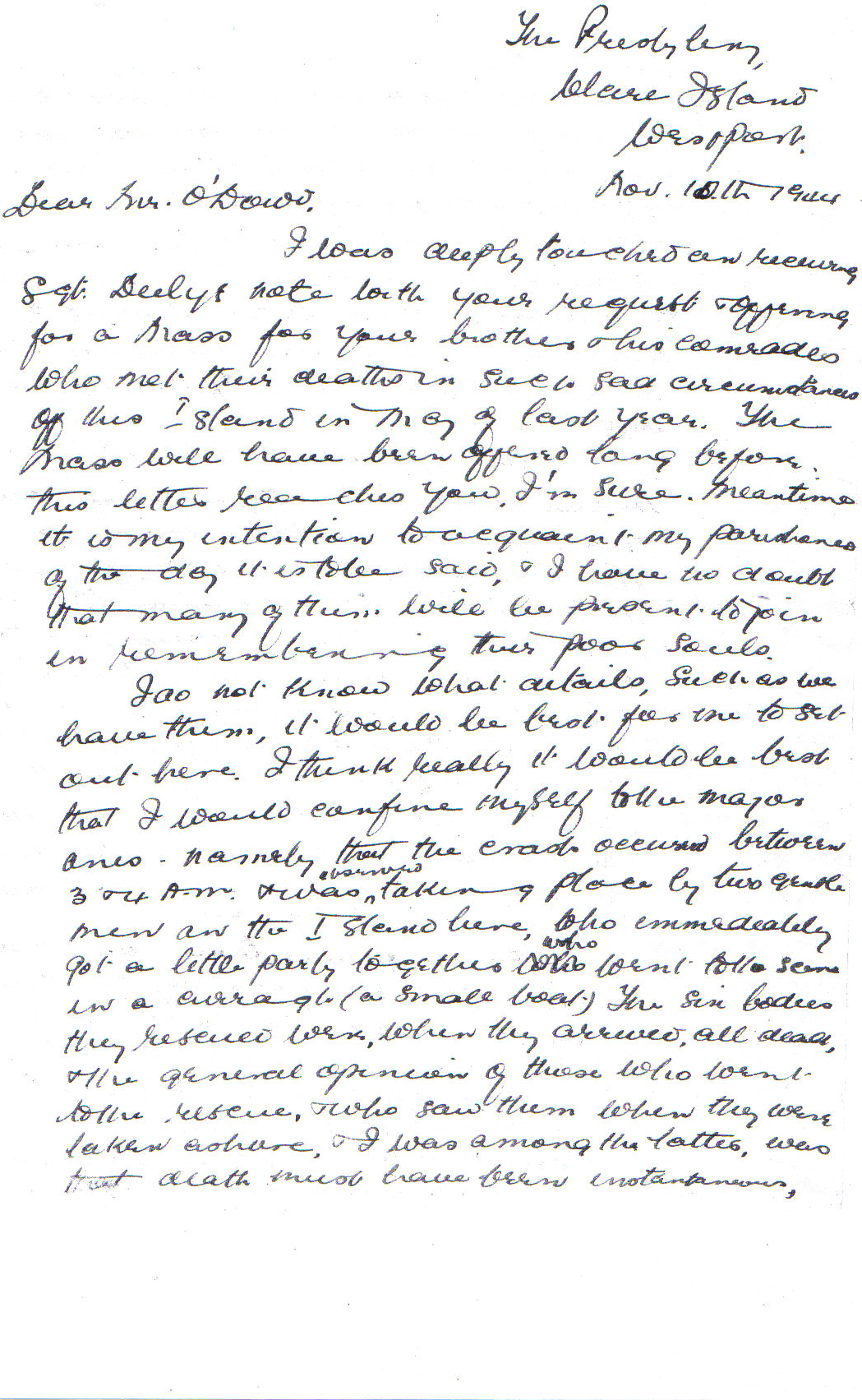
"I was deeply touched on viewing Sgt. Deelys note with your
request & offering for a mass for your brother & his
comrades who met their deaths in such sad circumstances off
this island in May of last year. The mass will have
been offered long before this letter reaches you I'm
sure. Meantime it is my intention to acquaint my
parishioners of the day it is to be said, & I have no
doubt that many of them them will be present to join in
remembering their poor souls.
I do not know what details, such as we have them, it
would be ???? for me to set out here. I think really
it would be best that I would confine myself to the major
ones, namely that the crash occurred between 3 - 4a.m. &
was observed taking place by two gentle men on the island
here, who immediately got a little party together, who went
to the scene in a curragh (a small boat). The
six bodies they rescued were, when they arrived, all dead
& the general opinion of those who went to the rescue,
& who saw them when they were taken ashore, & I was
among the latter, was that death must have been
instantaneous,
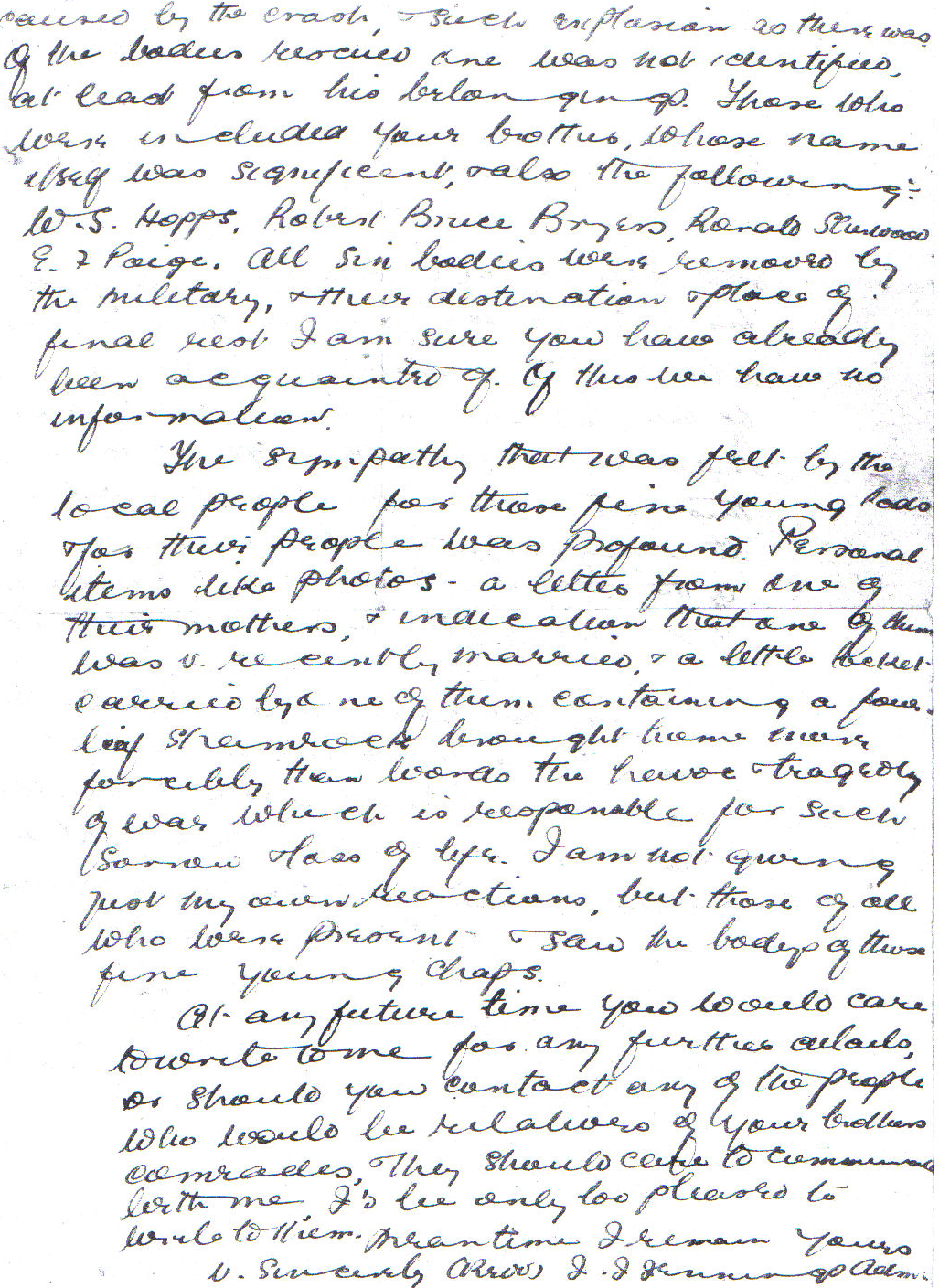
caused by the crash, & such explosions as there
was. Of the bodies rescued one was not identified, at
least from his belongings. Those who were included
your brother, whose name itself was significant, & also
the following -:
W. S. Hopps, Robert Bruce Bryers, Ronald Sherwood, E.
F. Paige. All six bodies were removed by the military,
& their destination & place of final rest I am sure
you have already been acquainted of. Of this we have
no information.
The sympathy that was felt by the local people for
those fine young men lads & for their people was
profound. Personal items like photos - a letter from
one of their mothers & indication that one of them was v
recently married, & a little pocket carried by one of
them, containing a four leaf shamrock brought home more
forcibly than words the havoc? & tragedy of war which is
responsible for such sorrow and loss of life. I am not
giving just my own reactions but those of all who were
present. I saw the bodies of those fine young chaps.
At any future time you would care to write to me for
any further details or should you contact any of the people
who would be relatives of your brothers comrades, & they
should care to communicate with me. I'll be only too
pleased to write to them.
Meantime I remain yours
v. sincerely
(Revd)
The letter sent by Sgt Deely stationed in Louisburgh,
County Mayo. This was the closest Garda Station on the
mainland next to Clare Island.
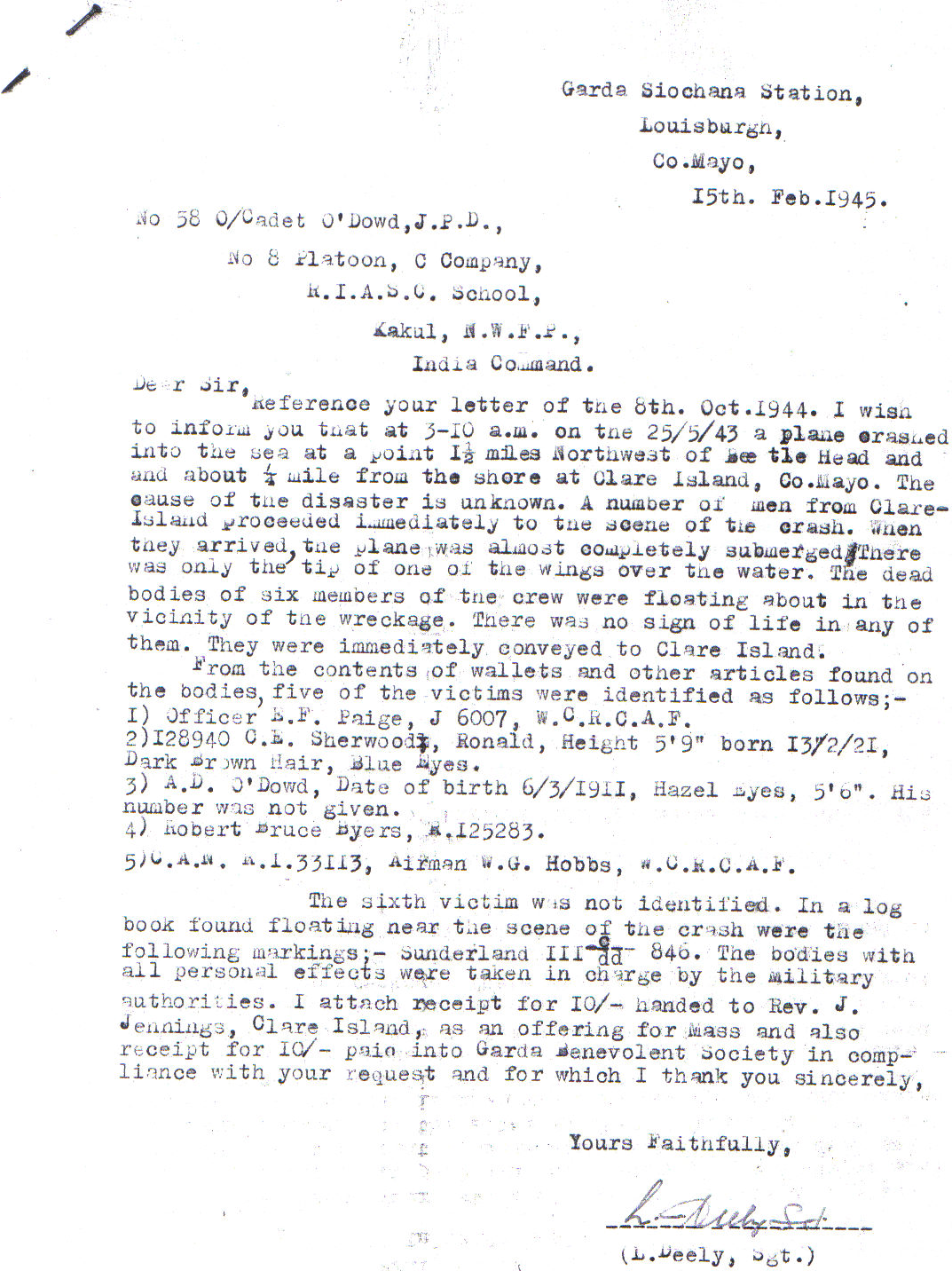
Download Free Adobe Reader from 




















